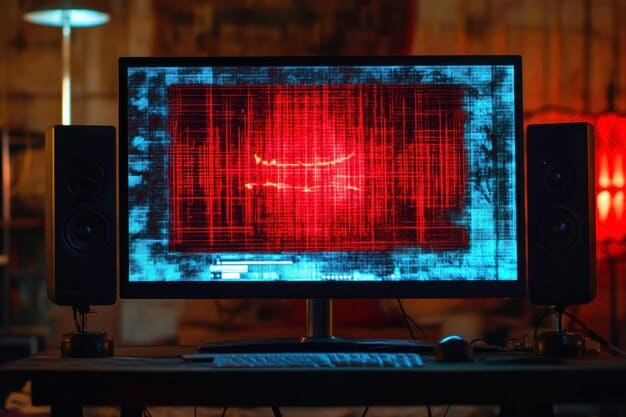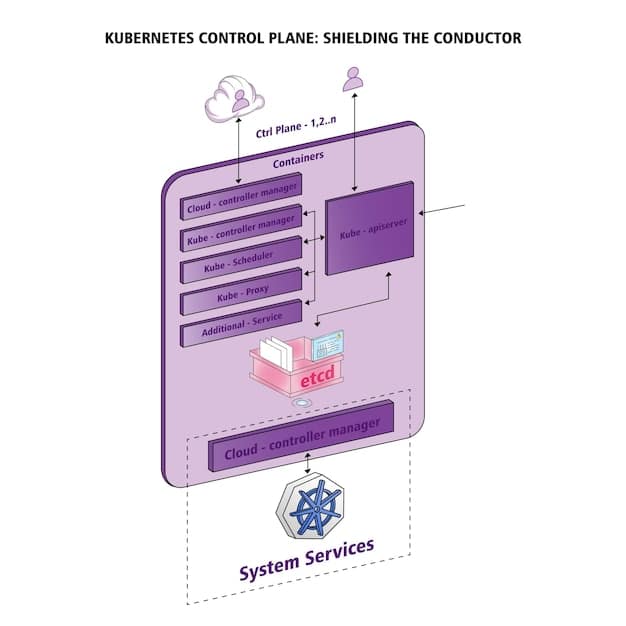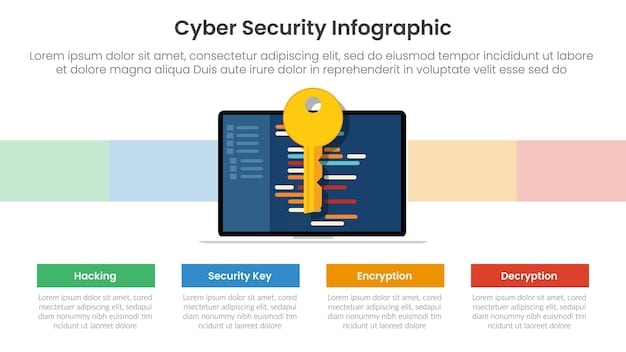Building Secure Smart Contracts: US Developers’ Guide to Best Practices

Building secure smart contracts involves navigating common pitfalls and implementing best practices, especially for US developers aiming to create robust and trustworthy decentralized applications.
The world of smart contracts offers immense potential, but also presents unique security challenges. For US developers, understanding and mitigating these risks is crucial for building secure smart contracts that function as intended and remain impervious to attacks.
Understanding Smart Contract Security
Smart contract security is paramount because once deployed, smart contracts are often immutable and any vulnerabilities can lead to significant financial losses. It’s essential to recognize that a secure smart contract is not just about writing code that compiles; it’s about anticipating potential threats and designing defenses against them.
The Importance of Secure Smart Contracts
Secure smart contracts are the cornerstone of trustworthy decentralized applications. Without robust security measures, these applications are vulnerable to exploitation, losing funds, and undermining the trust of users.
- Financial Security: Preventing loss of funds due to exploits.
- Data Integrity: Ensuring data remains accurate and unaltered.
- Reputation: Building and maintaining trust with users and stakeholders.
Therefore, developers need to adopt a comprehensive approach that covers all aspects of development.

Common Security Pitfalls in Smart Contract Development
Several common pitfalls can undermine the security of smart contracts. By understanding these vulnerabilities, developers can take proactive steps to mitigate them.
Reentrancy Attacks
Reentrancy attacks occur when a contract calls another contract and, before its state is updated, the external contract makes a recursive call back to the original contract, potentially draining funds or manipulating state variables.
Mitigation strategies include using the “checks-effects-interactions” pattern, which ensures state changes are executed before external calls, and employing reentrancy guard modifiers.
Integer Overflow and Underflow
Integer overflow and underflow happen when arithmetic operations result in values that exceed or fall below the maximum or minimum representable value for a given data type.
To avoid these issues, use safe math libraries like OpenZeppelin’s SafeMath, which automatically check for overflow and underflow conditions and throw exceptions when they occur.
Timestamp Dependence
Relying on block timestamps for critical logic can introduce vulnerabilities, as miners have some control over timestamp values. This can lead to unintended consequences and manipulation.
Avoid using block timestamps for critical logic. If you must use them, understand the limitations and potential for manipulation. Consider using alternative sources of randomness or timekeeping that are less susceptible to miner influence.
Understanding these common pitfalls is the first step toward building more resilient contracts.
Best Practices for Writing Secure Smart Contracts
Adopting best practices in smart contract development can significantly improve security. This includes utilizing security audits, code reviews, and testing strategies.
Conduct Thorough Security Audits
A security audit is an essential step in ensuring the robustness of a smart contract. It involves having a third-party expert review the code for vulnerabilities and potential attack vectors.
- Expert Review: Independent assessment by security professionals.
- Vulnerability Identification: Detection of potential weaknesses.
- Mitigation Recommendations: Suggestions for addressing vulnerabilities.
Implement Comprehensive Testing Strategies
Comprehensive testing is critical to identify and fix bugs early in the development process. This includes unit testing, integration testing, and fuzzing.
Unit tests verify the functionality of individual components, integration tests ensure components work together correctly, and fuzzing involves automatically generating and inputting random data to uncover vulnerabilities.
Follow Secure Coding Principles
Secure coding principles guide developers in writing code that is less prone to vulnerabilities. These include using robust error handling, minimizing code complexity, and adhering to established patterns.
By following these principles, developers can reduce the likelihood of introducing security flaws into their contracts. Thoroughly test and audit all smart contracts before deployment to ensure they are free from vulnerabilities.

Leveraging Security Tools and Frameworks
Various tools and frameworks can aid in the development of secure smart contracts. These range from static analysis tools to formal verification systems.
Static Analysis Tools
Static analysis tools automatically analyze source code for potential vulnerabilities without executing the code. These tools can detect common issues such as reentrancy, integer overflow, and timestamp dependence.
Examples include Slither, Mythril, and SmartCheck, which offer valuable insights into potential security flaws.
Formal Verification
Formal verification involves mathematically proving the correctness of a smart contract. This technique can provide a high degree of assurance that the contract behaves as intended, even under adversarial conditions.
While formal verification can be complex and time-consuming, it can be crucial for high-stakes contracts.
Security Frameworks
Security frameworks provide a set of tools and libraries that simplify the development of secure smart contracts. These frameworks often include features such as safe math libraries, reentrancy guards, and access control mechanisms.
The OpenZeppelin Contracts library is a popular choice, providing a collection of pre-built, well-tested smart contracts and components.
By leveraging these tools and frameworks, developers can improve the security and reliability of their smart contracts.
Legal and Regulatory Considerations for US Developers
US developers must be aware of the legal and regulatory landscape surrounding smart contracts and blockchain technology. This includes understanding securities laws, data privacy regulations, and anti-money laundering (AML) requirements.
Compliance with Securities Laws
The Securities and Exchange Commission (SEC) has taken the position that some digital assets and token offerings may be considered securities under US law. Developers involved in creating and offering such assets must comply with securities regulations.
Failure to do so can result in significant penalties and legal consequences.
Data Privacy Regulations
Smart contracts that handle personal data must comply with data privacy regulations such as the California Consumer Privacy Act (CCPA) and the General Data Protection Regulation (GDPR). These regulations impose obligations on businesses regarding the collection, use, and protection of personal data.
Developers must design their contracts to ensure compliance with these regulations, including providing mechanisms for users to access, correct, and delete their data.
Anti-Money Laundering (AML) Requirements
Smart contract applications that facilitate financial transactions may be subject to anti-money laundering (AML) requirements. This includes implementing know-your-customer (KYC) procedures and monitoring transactions for suspicious activity.
Developers should consult with legal counsel to ensure compliance with AML regulations.
Understanding these legal and regulatory considerations is essential for US developers working with smart contracts and blockchain technology.
The Future of Smart Contract Security
As smart contracts become more prevalent, the field of smart contract security will continue to evolve. New tools, techniques, and best practices will emerge to address emerging threats and challenges.
Advancements in Formal Verification
Formal verification techniques are becoming more accessible and sophisticated. Future advancements may make it easier to formally verify complex smart contracts, providing a higher degree of assurance in their correctness.
This could lead to wider adoption of formal verification in high-stakes applications.
AI-Powered Security Tools
Artificial intelligence (AI) and machine learning (ML) are being used to develop more advanced security tools. These tools can automatically detect vulnerabilities, analyze code behavior, and predict potential attacks.
AI-powered security tools can provide a valuable layer of defense against emerging threats.
Community Collaboration
Collaboration within the smart contract development community is essential for improving security. Sharing knowledge, best practices, and threat intelligence can help developers stay ahead of attackers.
Open-source projects, bug bounty programs, and security conferences can facilitate this collaboration.
The future of smart contract security will depend on continuous innovation, collaboration, and adaptation to emerging threats.
| Key Point | Brief Description |
|---|---|
| 🔑 Security Audits | Independent security experts assess code for vulnerabilities. |
| 🧪 Testing Strategies | Employ unit, integration, and fuzzing tests for robust validation. |
| 🛡️ Secure Coding | Adhere to principles like error handling and minimizing complexity. |
| ⚖️ Legal Compliance | Consider US securities laws, privacy regulations, and AML requirements. |
Frequently Asked Questions
▼
Common vulnerabilities include reentrancy attacks, integer overflow/underflow, timestamp dependence, and mishandled exceptions. Reentrancy can drain funds, while integer issues can lead to unexpected logic errors.
▼
A security audit is crucial. It provides an expert, unbiased analysis of the code, identifying potential weaknesses that might be missed during development. Audits enhance trust and security.
▼
Tools like Slither and Mythril help with static analysis. OpenZeppelin’s contracts offer secure, pre-built components. Formal verification can provide mathematical proof of correctness for critical contracts.
▼
US developers must comply with securities laws, data privacy regulations (CCPA), and AML requirements. Token offerings may be securities. Privacy is governed by CCPA. AML impacts financial transactions.
▼
The future involves advanced formal verification, AI-powered security tools, and greater community collaboration. Formal verification is becoming easier. AI tools will automate vulnerability detection. Community sharing is key.
Conclusion
Building secure smart contracts is a complex but essential task for US developers. By understanding common pitfalls, applying best practices, leveraging security tools, and considering legal and regulatory factors, developers can create robust, trustworthy, and compliant decentralized applications.





